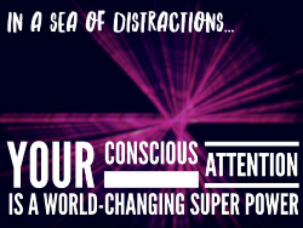Yoga is about using your mind, in many different ways, even to get what you want … as long as it is for a higher good for everyone.
The monkey mind as they say in yoga, or the ceaseless hamster wheel is our mind constantly turning thoughts. Try to slow down the monkey mind. Without the ceaseless flow of random of thoughts ~ we can liberate our mind from constant, draining day to day thoughts that take our energy but don’t really do anything for us.
Then choose to apply your focused attention at will. See what you can create or accomplish with that.
Or see what you can heal with that.

From KellyBroganMD.com
Try it — if you have a symptom that is challenging you, spend 5-10 minutes a day simply focusing on that body part, seeing healing in your mind while holding distractions at the perimeter of your protective bubble. Simply attend, and see what happens.
Inner Contemplation – watching our thoughts and feelings
Yoga needs to have an internal contemplation to be yoga. Contemplation is defined as an inner seeing or inner vision with a spiritual component — or even a mystical awareness. Constant thinking blocks our inner vision — inner knowing — intuition.
Enter my favorite new word:
Inter-o-ception
Sometimes described as ‘the hidden sense’, interoception is all about the sensory signals inside our own body, from our own organs. On a very basic level this is knowing when you need to go to the bathroom or when you are hungry.
I don’t know how new the word is, it is not recognized by my spell checker, but suddenly I am hearing it in different settings, like with children on the spectrum there is interoception training to help pay better attention to your body’s own signals.
Once we start to realize we can learn to listen to more of what our body is saying we can we can tap into any bodily functions that need tending to, including sensing pain, breathing rate, heart rate, and even sensing signals happening within the body, such as changes in excitability or the calming of sensory neurons that influence stress control, the vagus nerve, and how our autonomic balance (fight or flight vs. rest and digest) affect an organ system’s functioning. This is also being studied in how we can use this to help control our own cardiovascular function, breathing and metabolism.
Our interoceptive system can also help us regulate our emotions and levels of excitement or anger.
It even has the attention of allopathic medicine! It is currently being researched by the University of Iowa who has a rich history of accomplishments in these areas.
There is no branch of allopathic medicine that focuses on autonomic functions, while this is the main focus of yoga and many alternative medicines — and it hugely affects disease progression in any of the major specialties such as cardiology, neurology, gastroenterology, nephrology, which currently only focus on specific organs. The balance in our nervous system is critically important in the regulation of all organ systems, and consequently its dysregulation and how that affects homeostasis. Autonomic dysregulation is a major cause of morbidity and mortality in many different disorders and diseases, such as pain, aging, cognitive health, psychiatry and more.
The importance of autonomic balance is getting attention in modern medical circles and new interventions are being developed that influence this balance — sadly most of them are pharmacologically, gene based, or devise based with vagal nerve stimulation. But we know our yoga practice does this without those interventions.
I recently listened to a podcast with Stephanie Carter Kelley, PT PhD
She is a PT and educator turned yoga teacher, she now calls herself a Yoga Physical Therapist. She saw and participated in several studies that compared 1:1 physical therapy sessions to group yoga classes. Guess what? No difference in benefit. Taking a yoga class has the same benefit as physical therapy. How yoga teaches us regulation of our nervous systems is one of the main reasons why it has such value in this arena and many others.
How did the yogis know this hundreds of years ago? This is basically the very principal that is yoga — using breathing, bandhas, postures, and meditation which gives us control of autonomic systems previously thought to be out of our control.
Autonomic balance is the secret to healing and preventing diseases.
By engaging our mind in what we are doing in yoga — adding the internal contemplation element which improves our interoception we can increase the benefits of what we are doing on our mats.
Let’s apply this to bhastrika pranayama, the bellows breath.
As you pump your breath for the bellows breath see your heart and lungs strengthening and stretching, getting cleared out and being energized.
Then as you hold your breath, feel calm, feel your body be still, let peace pervade your body — clarity in your mind, uplifting, close your eyes and feel prana being absorbed in your body, see your third eye, see it light up and activate giving you clear seeing and understanding, see the vessels in your body — your nadis, opening and flowing freely, see good communication from your root chakra to your brain, this is your body increasing prana.
Add your mula bandha (squeeze your anus), your external anal sphincter and contract it, this helps you access your nervous system and turn on the calm, mula bandha is stimulating a nerve (pelvic splanchnic nerve) that is also connected to our rest and digest nervous system, and helps to regulate the vagus nerve.
See your energy rise up your vagus nerve to your head, lighting up your eyes and brain, engaging you, connecting you to others.
